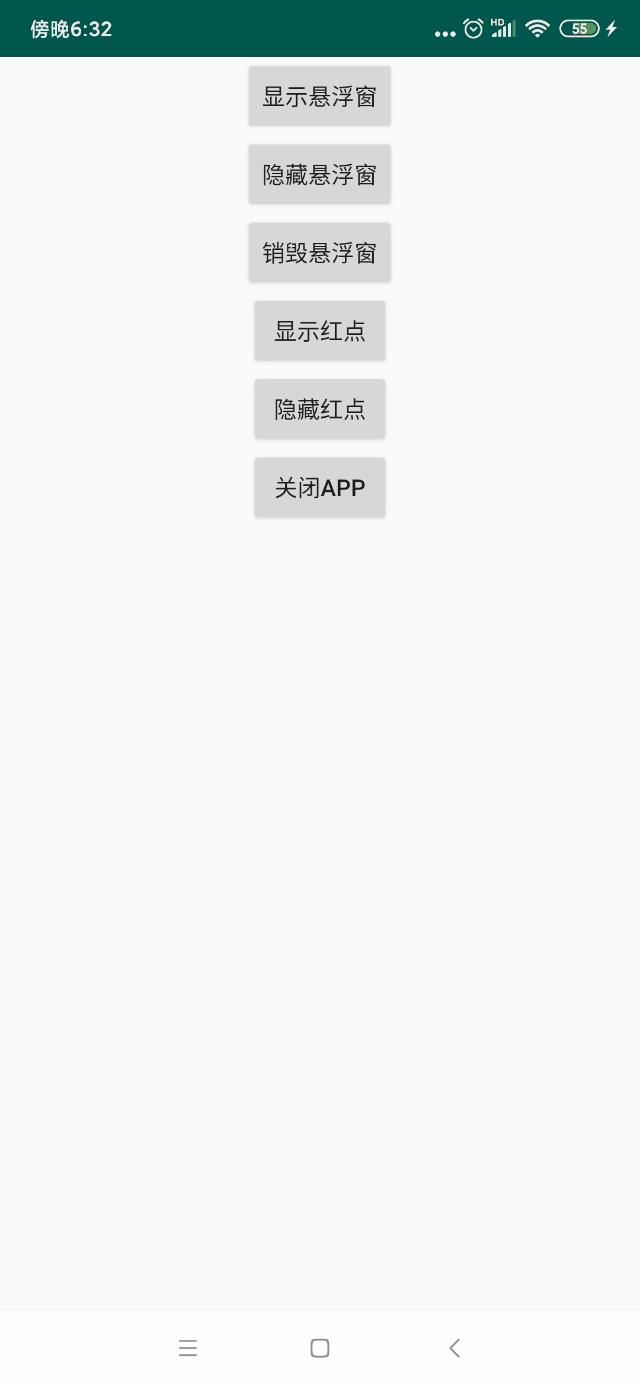Android 实现无需权限的悬浮球效果,可适配至Android 10
Posted houruoyu3
tags:
篇首语:本文由小常识网(cha138.com)小编为大家整理,主要介绍了Android 实现无需权限的悬浮球效果,可适配至Android 10相关的知识,希望对你有一定的参考价值。
前言:
最近闲来无事,突然想起搞一下悬浮球,之前的项目的悬浮球一直都需要授权,android6.0以后需要手动授权,悬浮球使用时就非常不便,这里为大家带来一种无需权限的悬浮球实现方式。
- 无需权限!
- 无需权限!
功能:
- 自动贴边
- 显示红点
- 隐藏红点
- 自由移动
- 显示悬浮球
- 隐藏悬浮球
- 销毁悬浮球
- 接入简单,可进行自定义拓展
附上demo地址
效果如下:

以下是主要的代码部分:
MainActivity.class
public class MainActivity extends Activity
@Override
protected void onCreate(Bundle savedInstanceState)
super.onCreate(savedInstanceState);
setContentView(R.layout.activity_main);
findViewById(R.id.showbtn).setOnClickListener(new View.OnClickListener()
@Override
public void onClick(View view)
RoundView.getInstance().showRoundView(MainActivity.this);
);
findViewById(R.id.hidebtn).setOnClickListener(new View.OnClickListener()
@Override
public void onClick(View view)
RoundView.getInstance().hideRoundView(MainActivity.this);
);
findViewById(R.id.closebtn).setOnClickListener(new View.OnClickListener()
@Override
public void onClick(View view)
RoundView.getInstance().closeRoundView(MainActivity.this);
);
findViewById(R.id.showMsgbtn).setOnClickListener(new View.OnClickListener()
@Override
public void onClick(View view)
RoundView.getInstance().showRoundMsg();
);
findViewById(R.id.hideMsgbtn).setOnClickListener(new View.OnClickListener()
@Override
public void onClick(View view)
RoundView.getInstance().hideRoundMsg();
);
findViewById(R.id.exitbtn).setOnClickListener(new View.OnClickListener()
@Override
public void onClick(View view)
android.os.Process.killProcess(android.os.Process.myPid());
);
RoundView.class
/**
* 悬浮窗管理器
*/
public class RoundView
private static RoundView sFloatingLayer;
/**
* 用于控制在屏幕上添加或移除悬浮窗
*/
private static WindowManager mWindowManager;
public static boolean isNearLeft = true; //判断悬浮球是否在左边
private static boolean isShow = false; //判断悬浮球是否已经显示
private int mWidth,mHeight; //屏幕的宽高
public static final int WIN_NONE = 0;// 不展示
public static final int WIN_SMALL = 1;// 小浮标
public static final int WIN_BIG = 2;// 展开
public static final int WIN_HIDE = 3;// 靠边隐藏 无操作隐藏
public static int winStatus;
public static boolean isMsg=false; //红点消息提示是否显示
/**
* 小悬浮窗view的实例
*/
private static RoundWindowSmallView smallWindow;
/**
* 隐藏悬浮窗view的实例
*/
private static RoundWindowHideView hideWindow;
/**
* 大悬浮窗view的实例
*/
private static RoundWindowBigView bigWindow;
/**
* 大小悬浮窗view的参数
*/
private static WindowManager.LayoutParams mLayoutParams;
public static RoundView getInstance()
if (null == sFloatingLayer)
synchronized (RoundView.class)
if (null == sFloatingLayer)
sFloatingLayer = new RoundView();
return sFloatingLayer;
/**
* 显示悬浮窗
* @param context
*/
public void showRoundView(Context context)
if(mWindowManager==null)
mWindowManager = (WindowManager) context.getSystemService(Context.WINDOW_SERVICE);
//每一次显示浮窗前都重新获取一次宽高,避免横竖屏切换后宽高变化
getWidthAndHeight(context);
if(!isShow)
//处于非显示状态,可以显示
isShow=true;
if(winStatus==WIN_NONE)
//处于未创建状态,请创建
showSmallwin(context);
else
//已创建了,直接显示
switch (winStatus)
case WIN_SMALL:
if(smallWindow!=null)
smallWindow.setVisibilityState(View.VISIBLE);
break;
case WIN_BIG:
if(bigWindow!=null)
bigWindow.setVisibilityState(View.VISIBLE);
break;
case WIN_HIDE:
if(hideWindow!=null)
hideWindow.setVisibilityState(View.VISIBLE);
break;
/**
* 隐藏悬浮窗
* @param context
*/
public void hideRoundView(Context context)
if(isShow)
//处于显示状态,可以隐藏
isShow=false;
switch (winStatus)
case WIN_SMALL:
if(smallWindow!=null)
smallWindow.setVisibilityState(View.GONE);
break;
case WIN_BIG:
if(bigWindow!=null)
bigWindow.setVisibilityState(View.GONE);
break;
case WIN_HIDE:
if(hideWindow!=null)
hideWindow.setVisibilityState(View.GONE);
break;
/**
* 销毁悬浮窗
* @param context
*/
public void closeRoundView(Context context)
isShow=false;
isMsg=false;
winStatus=WIN_NONE;
removeSmallWindow(context);
removeBigWindow(context);
removeHideWindow(context);
/**
* 显示红点提示
*/
public void showRoundMsg()
if(!isMsg)
isMsg=true;
switch (winStatus)
case WIN_SMALL:
if(smallWindow!=null)
smallWindow.showRoundMsg();
break;
case WIN_BIG:
if(bigWindow!=null)
bigWindow.showRoundMsg();
break;
case WIN_HIDE:
if(hideWindow!=null)
hideWindow.showRoundMsg();
break;
/**
* 隐藏红点提示
*/
public void hideRoundMsg()
if(isMsg)
isMsg=false;
switch (winStatus)
case WIN_SMALL:
if(smallWindow!=null)
smallWindow.hideRoundMsg();
break;
case WIN_BIG:
if(bigWindow!=null)
bigWindow.hideRoundMsg();
break;
case WIN_HIDE:
if(hideWindow!=null)
hideWindow.hideRoundMsg();
break;
/**
* 显示小悬浮窗
* @param context context
*/
public void showSmallwin(final Context context)
new Handler().postDelayed(new Runnable()
@Override
public void run()
createSmallWindow(context);
removeBigWindow(context);
removeHideWindow(context);
, 500);
/************************************************ 创建窗口 ************************************************************/
/**
* 创建一个小悬浮窗。初始位置在屏幕的左上角位置
*
* @param context 必须为应用程序的Context
*/
public void createSmallWindow(Context context)
//每一次创建前都要重新获取宽高,不然横竖屏切换时会出问题
getWidthAndHeight(context);
if (smallWindow == null)
smallWindow = new RoundWindowSmallView(context);
if (mLayoutParams == null)
mLayoutParams = new WindowManager.LayoutParams();
mLayoutParams.format = PixelFormat.RGBA_8888;// 解决带Alpha的32位png图片失真问题
mLayoutParams.gravity = Gravity.LEFT | Gravity.TOP; //显示在左上角
mLayoutParams.flags = WindowManager.LayoutParams.FLAG_NOT_TOUCH_MODAL | WindowManager.LayoutParams.FLAG_NOT_FOCUSABLE;
// 在设置宽高
mLayoutParams.x = 0;
mLayoutParams.y = context.getResources().getDisplayMetrics().heightPixels / 3 * 2;
mLayoutParams.width = WindowManager.LayoutParams.WRAP_CONTENT;
mLayoutParams.height = WindowManager.LayoutParams.WRAP_CONTENT;
mLayoutParams.type = WindowManager.LayoutParams.TYPE_APPLICATION_ATTACHED_DIALOG; //设置悬浮窗的层次
if (!isNearLeft) // 当在屏幕右侧时 重新计算x坐标
int w = View.MeasureSpec.makeMeasureSpec(0, View.MeasureSpec.UNSPECIFIED);
int h = View.MeasureSpec.makeMeasureSpec(0, View.MeasureSpec.UNSPECIFIED);
smallWindow.measure(w, h);
if (Configuration.ORIENTATION_LANDSCAPE == context.getResources().getConfiguration().orientation) // 横屏
mLayoutParams.x = mWidth - smallWindow.getMeasuredWidth();
else // 竖屏
mLayoutParams.x = mWidth - smallWindow.getMeasuredWidth();
smallWindow.setParams(mLayoutParams);
// 将悬浮球添加到窗体
if (smallWindow.getParent() == null)
mWindowManager.addView(smallWindow, mLayoutParams);
winStatus=WIN_SMALL;
smallWindow.timehide();// 小悬浮窗3s后隐藏动画
/**
* 将小悬浮窗从屏幕上移除
*
* @param context 必须为应用程序的context
*/
public void removeSmallWindow(Context context)
if (smallWindow != null)
smallWindow.stopDelayed();
if (context != null)
if (mWindowManager != null)
try
mWindowManager.removeView(smallWindow);
catch (Exception e)
smallWindow = null;
else
smallWindow = null;
/**
* 创建一个隐藏悬浮窗。
*
* @param context 必须为应用程序的Context
*/
public void createHideWindow(Context context)
//每一次创建前都要重新获取宽高,不然横竖屏切换时会出问题
getWidthAndHeight(context);
if (hideWindow == null)
int w = View.MeasureSpec.makeMeasureSpec(0, View.MeasureSpec.UNSPECIFIED);
int h = View.MeasureSpec.makeMeasureSpec(0, View.MeasureSpec.UNSPECIFIED);
smallWindow.measure(w, h);// 测量
int width = smallWindow.getMeasuredWidth();// 获得视图实际宽度(测量宽度)
if (isNearLeft)
hideWindow = new RoundWindowHideView(context);
else
hideWindow = new RoundWindowHideView(context);
mLayoutParams.x = mLayoutParams.x + width / 2;
mWindowManager.addView(hideWindow, mLayoutParams);
winStatus=WIN_HIDE;
/**
* 将隐藏悬浮窗从屏幕上移除
*
* @param context 必须为应用程序的context
*/
public void removeHideWindow(Context context)
if (hideWindow != null)
if (context != null)
if (mWindowManager != null)
mWindowManager.removeView(hideWindow);
hideWindow = null;
/**
* 创建一个大悬浮窗。
*
* @param context 必须为应用程序的Context
*/
public void createBigWindow(Context context)
//每一次创建前都要重新获取宽高,不然横竖屏切换时会出问题
getWidthAndHeight(context);
int w = View.MeasureSpec.makeMeasureSpec(0, View.MeasureSpec.UNSPECIFIED);
int h = View.MeasureSpec.makeMeasureSpec(0, View.MeasureSpec.UNSPECIFIED);
if (bigWindow == null)
if (smallWindow != null)
smallWindow.measure(w, h);
else if (hideWindow != null)
hideWindow.measure(w, h);
bigWindow = new RoundWindowBigView(context);
bigWindow.measure(w,h);
if (mLayoutParams.x>(mWidth-bigWindow.getMeasuredWidth()))
// 在右边拖动的时候需要减去虚拟按钮
mLayoutParams.x = mWidth-bigWindow.getMeasuredWidth();
mLayoutParams.type = WindowManager.LayoutParams.TYPE_APPLICATION_SUB_PANEL+1; //设置悬浮窗的层次 数据越大则越下面
mWindowManager.addView(bigWindow, mLayoutParams);
winStatus=WIN_BIG;
/**
* 将大悬浮窗从屏幕上移除
*
* @param context 必须为应用程序的context
*/
public void removeBigWindow(Context context)
if (bigWindow != null)
if (context != null)
if (mWindowManager != null)
mWindowManager.removeView(bigWindow);
bigWindow = null;
/**
* 获取全屏状态下的宽高
* @param context
*/
public void getWidthAndHeight(Context context)
mWidth=context.getResources().getDisplayMetrics().widthPixels;
mHeight = context.getResources().getDisplayMetrics().heightPixels;
//有的手机是有虚拟导航键的,当横屏且全屏时,悬浮球无法靠到最右边,所以要用包含虚拟导航键的屏幕宽度
Point point = new Point();
if (mWindowManager != null)
if (Build.VERSION.SDK_INT >= Build.VERSION_CODES.M)
mWindowManager.getDefaultDisplay()以上是关于Android 实现无需权限的悬浮球效果,可适配至Android 10的主要内容,如果未能解决你的问题,请参考以下文章